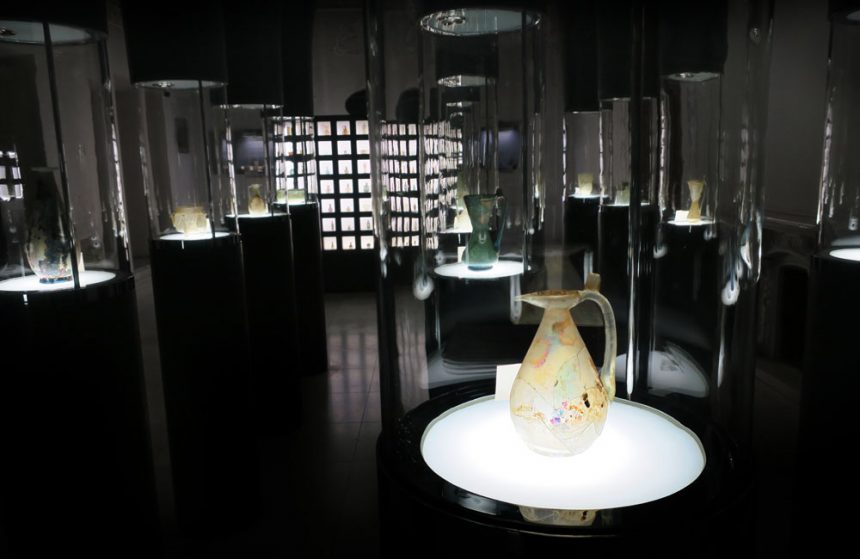ABOUT ABGINEH MUSEUM
The Abgineh Museum is home to a specialized collection of ancient Persian ceramics and glasswork. This historic 1,040 m2 octagonal-designed building and its decorative entryway columns, were constructed during the Qajar Dynasty to the order of Ahmad Ghavam (Qavam Al-Saltaneh). Until 1951 (solar year 1330), this building was his personal residence and place of work. Before becoming a museum, this building had also been the Egyptian and Afghani embassy, as well as a bank (Bazargani Bank).
After being purchased to become a museum, the building underwent a renovation and repair project by Austrian, German and Iranian engineering teams under the supervision of Hans Hollein. This prized structure, being located in a 7,000 m2 garden, is a fusion of European and Iranian architecture. It presents various displays of intricate brickwork on its facade, as well as beautiful and elegant plasterwork, mirrorwork and wood carving on the interior. Between the years 1977-78, additional buildings have been constructed north and south of the museum that have transformed this 7,000 m2 garden into a cultural center.
CRYSTAL HALL (Bolour)
This collection of items consists of glass and crystal objects that date back to the pre- and early Islamic Eras. Various techniques such as sand casting, blow molding, free-blown, decorative painting, carving…etc. were used in the creation of these exceptional objects. Among the most valuable objects in this hall are carved bowls from the Sasanian Empire and a glass bowl from the Achaemenid Empire.
LAPIS LAZULI HALL 1 (Lajevard)
The diverse ceramic artifacts presented in this hall belong to the late 12th – 17th century AD. These items belong to the Ilkhanate (Ilkhanid) through to the Safavid Dynasty; alongside the Gorgan collection. Among the beautiful carnations of this hall are intricate ceramics decorated with relief carvings or Niello brush (siah ghalam technique) designs.
LAPIS LAZULI HALL 2 (Lajevard)
The glass items in this hall belong to the 17th – 19th century AD. Among the artifacts, this hall also holds a nine-piece ceramic table, painted in the Ghahveh Khaneh-ee (coffee house) style, which features the heroes and stories of world renowned Ferdowsi’s Shahnameh.
ENAMEL HALL (Mina)
This hall presents some of the oldest glass and ceramic artifacts from the ancient Elamite holy city of Chogha Zanbil, Valehaye Madar and Dasht-e Ghazvin. Ancient perfume bottles and jewelry make the main items on display here.
PEARL SHELL HALL (Sadaf)
The objects here are from the 9th and 10th centuries AD. The clay carnations, known as Neyshabur Ceramics (Sofalinehaye Neyshabur), sit next to a variety of glass and ceramic objects from various Islamic periods; displaying decorative drawing, two-color and enameling techniques. .
THE AUDIO & VISUAL HALL (Sam-i Basar-i)
In this hall, the ways and techniques of the excavation of a historic site are unveiled. The display in the floor here, represents a real-life excavation site. There is also a map showing a comparison of the dissemination of historical artifacts of ancient Iran, relative to other ancient civilizations; alongside the presentation of a film.
GOLDEN SHADES HALL (Zarrin Faam)
This hall exhibits special enameled ceramic dishware decorated with inscriptions dating back to the 10th – 14th centuries AD. This special style of enamel is involved in using different metals (copper, silver and gold) when coating the ceramic (zarrin faam & minaai style). Many of the items depict scenes from mythical stories and legends alongside poetic inscriptions from world famous Nezami (Nizami) and Ferdowsi.
THE LIBRARY (Ketab Khaneh)
This museum houses a specialized library on its bottom floor; elaborately decorated with beautiful tiles and relief carvings reflecting images from Shahnameh stories. This library holds around 4,000 books in English and Farsi in fields such as archeology, history, architecture, art, sociology…etc. It is open to public and, only by presenting an identification card, visitors are permitted to view, take pictures of and copy any of the books within the library..
MUSEUM ENTRANCE AREAS (Sar Saraha)
The upper antechamber of this museum displays clay and glass artifacts from various Islamic periods. The lower one holds fine examples of opaline glass and crystal items, made in France during the 18th and 19th centuries; many of which have carvings and engravings.
City/Town: Tehran
Street Address: No. 59, Sie tir St., Jomhouri Ave.
Telephone: (+98-21) 66708153-4
Website: www.glasswaremuseum.org
Operating Days: Every days
Operating Hours: 9am – 5pm Sun-Thu
Typical Price: 150.000 Rils.
Neighbourhood: National museum (Iran Bastan) – Post museum – Communication museum – Naderi Café – Iran Science & Technology Museum


